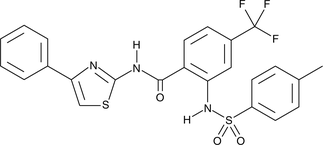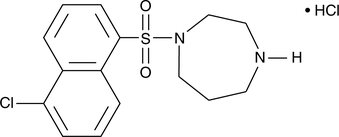Cayman
Showing 29851–30000 of 45550 results
-
ML-311 is an inhibitor of myeloid cell leukemia-1 (Mcl-1; IC50 = 0.31 µM in a fluorescence polarization assay).{48699} It is selective for Mcl-1 over Bcl-xL (IC50 = >40 µM). ML-311 decreases the proliferation of 13 cancer cell lines (EC50s = 0.3-25 µM).
Brand:CaymanSKU:29445 - 1 mgAvailable on backorder
ML-311 is an inhibitor of myeloid cell leukemia-1 (Mcl-1; IC50 = 0.31 µM in a fluorescence polarization assay).{48699} It is selective for Mcl-1 over Bcl-xL (IC50 = >40 µM). ML-311 decreases the proliferation of 13 cancer cell lines (EC50s = 0.3-25 µM).
Brand:CaymanSKU:29445 - 10 mgAvailable on backorder
ML-311 is an inhibitor of myeloid cell leukemia-1 (Mcl-1; IC50 = 0.31 µM in a fluorescence polarization assay).{48699} It is selective for Mcl-1 over Bcl-xL (IC50 = >40 µM). ML-311 decreases the proliferation of 13 cancer cell lines (EC50s = 0.3-25 µM).
Brand:CaymanSKU:29445 - 5 mgAvailable on backorder
The USP1 deubiquitinating enzyme, which regulates the DNA translesion synthesis (TLS) and Fanconi anemia (FA) DNA damage response pathways by deubiquitinating the central players of these pathways, is activated by the WD40-repeat containing UAF1 protein through formation of a stable USP1-UAF1 protein complex.{30972} ML-323 is an inhibitor of the USP1-UAF1 deubiquitinase complex with an IC50 value of 76 nM.{30973} It demonstrates excellent selectivity against other human deubiquitinases, deSUMOylase, deneddylase, and unrelated proteases.{30973} ML-323 has been shown to inhibit the deubiquitination of proliferating cell nuclear antigen and FA complementation group D2 by inhibiting USP1-UAF1 activity in H596 cells.{30973} ML-323 potentiates cisplatin (Item No. 13119) cytotoxicity in NSCLC H596 cells and U2OS osteosarcoma cells by targeting the TLS and FA DNA damage response pathways.{30973}
Brand:CaymanSKU:-Available on backorder
The USP1 deubiquitinating enzyme, which regulates the DNA translesion synthesis (TLS) and Fanconi anemia (FA) DNA damage response pathways by deubiquitinating the central players of these pathways, is activated by the WD40-repeat containing UAF1 protein through formation of a stable USP1-UAF1 protein complex.{30972} ML-323 is an inhibitor of the USP1-UAF1 deubiquitinase complex with an IC50 value of 76 nM.{30973} It demonstrates excellent selectivity against other human deubiquitinases, deSUMOylase, deneddylase, and unrelated proteases.{30973} ML-323 has been shown to inhibit the deubiquitination of proliferating cell nuclear antigen and FA complementation group D2 by inhibiting USP1-UAF1 activity in H596 cells.{30973} ML-323 potentiates cisplatin (Item No. 13119) cytotoxicity in NSCLC H596 cells and U2OS osteosarcoma cells by targeting the TLS and FA DNA damage response pathways.{30973}
Brand:CaymanSKU:-Available on backorder
The USP1 deubiquitinating enzyme, which regulates the DNA translesion synthesis (TLS) and Fanconi anemia (FA) DNA damage response pathways by deubiquitinating the central players of these pathways, is activated by the WD40-repeat containing UAF1 protein through formation of a stable USP1-UAF1 protein complex.{30972} ML-323 is an inhibitor of the USP1-UAF1 deubiquitinase complex with an IC50 value of 76 nM.{30973} It demonstrates excellent selectivity against other human deubiquitinases, deSUMOylase, deneddylase, and unrelated proteases.{30973} ML-323 has been shown to inhibit the deubiquitination of proliferating cell nuclear antigen and FA complementation group D2 by inhibiting USP1-UAF1 activity in H596 cells.{30973} ML-323 potentiates cisplatin (Item No. 13119) cytotoxicity in NSCLC H596 cells and U2OS osteosarcoma cells by targeting the TLS and FA DNA damage response pathways.{30973}
Brand:CaymanSKU:-Available on backorder
The USP1 deubiquitinating enzyme, which regulates the DNA translesion synthesis (TLS) and Fanconi anemia (FA) DNA damage response pathways by deubiquitinating the central players of these pathways, is activated by the WD40-repeat containing UAF1 protein through formation of a stable USP1-UAF1 protein complex.{30972} ML-323 is an inhibitor of the USP1-UAF1 deubiquitinase complex with an IC50 value of 76 nM.{30973} It demonstrates excellent selectivity against other human deubiquitinases, deSUMOylase, deneddylase, and unrelated proteases.{30973} ML-323 has been shown to inhibit the deubiquitination of proliferating cell nuclear antigen and FA complementation group D2 by inhibiting USP1-UAF1 activity in H596 cells.{30973} ML-323 potentiates cisplatin (Item No. 13119) cytotoxicity in NSCLC H596 cells and U2OS osteosarcoma cells by targeting the TLS and FA DNA damage response pathways.{30973}
Brand:CaymanSKU:-Available on backorder
ML-324 is a cell-permeable inhibitor of JMJD2E (KDM4DL; IC50 = 920 nM) that is inactive against lysine-specific demethylase, LSD1.{28754,28755} It reduces the expression of immediate early genes of Herpes simplex virus (IC50 = ~10 µM) and human cytomegalovirus, blocks viral infection, and suppresses the level of viral reactivation in a ganglia explant model of latently infected mice.{28754} The effects of ML-324 are reversible, as viral replication resumes after drug withdrawal.{28754}
Brand:CaymanSKU:-Available on backorder
ML-324 is a cell-permeable inhibitor of JMJD2E (KDM4DL; IC50 = 920 nM) that is inactive against lysine-specific demethylase, LSD1.{28754,28755} It reduces the expression of immediate early genes of Herpes simplex virus (IC50 = ~10 µM) and human cytomegalovirus, blocks viral infection, and suppresses the level of viral reactivation in a ganglia explant model of latently infected mice.{28754} The effects of ML-324 are reversible, as viral replication resumes after drug withdrawal.{28754}
Brand:CaymanSKU:-Available on backorder
ML-324 is a cell-permeable inhibitor of JMJD2E (KDM4DL; IC50 = 920 nM) that is inactive against lysine-specific demethylase, LSD1.{28754,28755} It reduces the expression of immediate early genes of Herpes simplex virus (IC50 = ~10 µM) and human cytomegalovirus, blocks viral infection, and suppresses the level of viral reactivation in a ganglia explant model of latently infected mice.{28754} The effects of ML-324 are reversible, as viral replication resumes after drug withdrawal.{28754}
Brand:CaymanSKU:-Available on backorder
ML-324 is a cell-permeable inhibitor of JMJD2E (KDM4DL; IC50 = 920 nM) that is inactive against lysine-specific demethylase, LSD1.{28754,28755} It reduces the expression of immediate early genes of Herpes simplex virus (IC50 = ~10 µM) and human cytomegalovirus, blocks viral infection, and suppresses the level of viral reactivation in a ganglia explant model of latently infected mice.{28754} The effects of ML-324 are reversible, as viral replication resumes after drug withdrawal.{28754}
Brand:CaymanSKU:-Available on backorder
ML-329 is an inhibitor of the microphthalmia-associated transcription factor (MITF) pathway with an IC50 value of 1.2 μM for promoter activity of the MITF target gene TRPM-1.{38954} It is selectively cytotoxic to the SK-MEL-5 and MALME-3M MITF-dependent melanoma cell lines over A375 MITF-independent cells (IC50s = 0.1, 0.7, and 70 μM, respectively).
Brand:CaymanSKU:22481 -Out of stock
ML-329 is an inhibitor of the microphthalmia-associated transcription factor (MITF) pathway with an IC50 value of 1.2 μM for promoter activity of the MITF target gene TRPM-1.{38954} It is selectively cytotoxic to the SK-MEL-5 and MALME-3M MITF-dependent melanoma cell lines over A375 MITF-independent cells (IC50s = 0.1, 0.7, and 70 μM, respectively).
Brand:CaymanSKU:22481 -Out of stock
ML-329 is an inhibitor of the microphthalmia-associated transcription factor (MITF) pathway with an IC50 value of 1.2 μM for promoter activity of the MITF target gene TRPM-1.{38954} It is selectively cytotoxic to the SK-MEL-5 and MALME-3M MITF-dependent melanoma cell lines over A375 MITF-independent cells (IC50s = 0.1, 0.7, and 70 μM, respectively).
Brand:CaymanSKU:22481 -Out of stock
ML-334 is an inhibitor of the protein-protein interaction between the transcription factor Nrf2 and its inhibitor Keap1.{57139} It binds to the Keap1 Kelch domain (IC50 = 1 µM) to induce dissociation and nuclear translocation of Nrf2 and activation of the antioxidant response element (ARE) in a cell-based assay (EC50 = 12 µM).
Brand:CaymanSKU:31439 - 1 mgAvailable on backorder
ML-334 is an inhibitor of the protein-protein interaction between the transcription factor Nrf2 and its inhibitor Keap1.{57139} It binds to the Keap1 Kelch domain (IC50 = 1 µM) to induce dissociation and nuclear translocation of Nrf2 and activation of the antioxidant response element (ARE) in a cell-based assay (EC50 = 12 µM).
Brand:CaymanSKU:31439 - 10 mgAvailable on backorder
ML-334 is an inhibitor of the protein-protein interaction between the transcription factor Nrf2 and its inhibitor Keap1.{57139} It binds to the Keap1 Kelch domain (IC50 = 1 µM) to induce dissociation and nuclear translocation of Nrf2 and activation of the antioxidant response element (ARE) in a cell-based assay (EC50 = 12 µM).
Brand:CaymanSKU:31439 - 5 mgAvailable on backorder
The μ-opioid receptor (OPRM1) is the primary site of action for morphine and other opioids associated with the treatment of pain. The occupancy of δ-opioid receptors (OPRD1) by antagonists has been shown to enhance OPRM1 binding and signaling activity.{24553} Because heteromerization of OPRM1 and OPRD1 is thought to be a potential mechanism by which this occurs, compounds are being sought that selectively activate OPRM1-OPRD1 heterodimerization while alleviating the unwanted effects associated with prolonged opiate use. ML-335 is the first identified agonist for OPRM1-OPRD1 heterodimerization (EC50 = 403 nM) that demonstrates selectivity over the individual OPRM1 and OPRD1 receptors and the serotonin HT5A receptor (EC50s = 14.9, 1.1, and >40 μM, respectively).{24553}
Brand:CaymanSKU:-The μ-opioid receptor (OPRM1) is the primary site of action for morphine and other opioids associated with the treatment of pain. The occupancy of δ-opioid receptors (OPRD1) by antagonists has been shown to enhance OPRM1 binding and signaling activity.{24553} Because heteromerization of OPRM1 and OPRD1 is thought to be a potential mechanism by which this occurs, compounds are being sought that selectively activate OPRM1-OPRD1 heterodimerization while alleviating the unwanted effects associated with prolonged opiate use. ML-335 is the first identified agonist for OPRM1-OPRD1 heterodimerization (EC50 = 403 nM) that demonstrates selectivity over the individual OPRM1 and OPRD1 receptors and the serotonin HT5A receptor (EC50s = 14.9, 1.1, and >40 μM, respectively).{24553}
Brand:CaymanSKU:-The μ-opioid receptor (OPRM1) is the primary site of action for morphine and other opioids associated with the treatment of pain. The occupancy of δ-opioid receptors (OPRD1) by antagonists has been shown to enhance OPRM1 binding and signaling activity.{24553} Because heteromerization of OPRM1 and OPRD1 is thought to be a potential mechanism by which this occurs, compounds are being sought that selectively activate OPRM1-OPRD1 heterodimerization while alleviating the unwanted effects associated with prolonged opiate use. ML-335 is the first identified agonist for OPRM1-OPRD1 heterodimerization (EC50 = 403 nM) that demonstrates selectivity over the individual OPRM1 and OPRD1 receptors and the serotonin HT5A receptor (EC50s = 14.9, 1.1, and >40 μM, respectively).{24553}
Brand:CaymanSKU:-The μ-opioid receptor (OPRM1) is the primary site of action for morphine and other opioids associated with the treatment of pain. The occupancy of δ-opioid receptors (OPRD1) by antagonists has been shown to enhance OPRM1 binding and signaling activity.{24553} Because heteromerization of OPRM1 and OPRD1 is thought to be a potential mechanism by which this occurs, compounds are being sought that selectively activate OPRM1-OPRD1 heterodimerization while alleviating the unwanted effects associated with prolonged opiate use. ML-335 is the first identified agonist for OPRM1-OPRD1 heterodimerization (EC50 = 403 nM) that demonstrates selectivity over the individual OPRM1 and OPRD1 receptors and the serotonin HT5A receptor (EC50s = 14.9, 1.1, and >40 μM, respectively).{24553}
Brand:CaymanSKU:-Venezuelan Equine Encephalitis Virus (VEEV) is a mosquito-borne alphavirus that can cause encephalomyelitis in all equine species and also in humans. ML-336 is a quinazolinone-based compound that has been shown to inhibit a VEEV-induced cytopathic effect in three strains of the virus (IC50s = 32, 20, and 41 nM for TC-83, V3526, and Trinidad donkey strains, respectively).{26236} It is reported to target the VEEV non-structural protein 2, which is necessary for transcription and replication of viral RNA.{26236}
Brand:CaymanSKU:9001920 - 1 mgAvailable on backorder
Venezuelan Equine Encephalitis Virus (VEEV) is a mosquito-borne alphavirus that can cause encephalomyelitis in all equine species and also in humans. ML-336 is a quinazolinone-based compound that has been shown to inhibit a VEEV-induced cytopathic effect in three strains of the virus (IC50s = 32, 20, and 41 nM for TC-83, V3526, and Trinidad donkey strains, respectively).{26236} It is reported to target the VEEV non-structural protein 2, which is necessary for transcription and replication of viral RNA.{26236}
Brand:CaymanSKU:9001920 - 10 mgAvailable on backorder
Venezuelan Equine Encephalitis Virus (VEEV) is a mosquito-borne alphavirus that can cause encephalomyelitis in all equine species and also in humans. ML-336 is a quinazolinone-based compound that has been shown to inhibit a VEEV-induced cytopathic effect in three strains of the virus (IC50s = 32, 20, and 41 nM for TC-83, V3526, and Trinidad donkey strains, respectively).{26236} It is reported to target the VEEV non-structural protein 2, which is necessary for transcription and replication of viral RNA.{26236}
Brand:CaymanSKU:9001920 - 25 mgAvailable on backorder
Venezuelan Equine Encephalitis Virus (VEEV) is a mosquito-borne alphavirus that can cause encephalomyelitis in all equine species and also in humans. ML-336 is a quinazolinone-based compound that has been shown to inhibit a VEEV-induced cytopathic effect in three strains of the virus (IC50s = 32, 20, and 41 nM for TC-83, V3526, and Trinidad donkey strains, respectively).{26236} It is reported to target the VEEV non-structural protein 2, which is necessary for transcription and replication of viral RNA.{26236}
Brand:CaymanSKU:9001920 - 5 mgAvailable on backorder
Insulin-degrading enzyme (IDE) is a thiol-sensitive zinc-metallopeptidase that acts as the major insulin-degrading protease in vivo, mediating the termination of insulin signaling.{26503} In addition to regulating insulin action in diabetes pathogenesis, IDE plays a role in Varicella-Zoster virus infection and degradation of amyloid-β, a peptide implicated in Alzheimer’s disease. ML-345 is a small molecule inhibitor that selectively targets cysteine819 in IDE with an EC50 value of 188 nM.{28670} It demonstrates 10-fold selectivity for IDE over a panel of enzymes with reactive cysteine residues.{28670}
Brand:CaymanSKU:-Available on backorder
Insulin-degrading enzyme (IDE) is a thiol-sensitive zinc-metallopeptidase that acts as the major insulin-degrading protease in vivo, mediating the termination of insulin signaling.{26503} In addition to regulating insulin action in diabetes pathogenesis, IDE plays a role in Varicella-Zoster virus infection and degradation of amyloid-β, a peptide implicated in Alzheimer’s disease. ML-345 is a small molecule inhibitor that selectively targets cysteine819 in IDE with an EC50 value of 188 nM.{28670} It demonstrates 10-fold selectivity for IDE over a panel of enzymes with reactive cysteine residues.{28670}
Brand:CaymanSKU:-Available on backorder
Insulin-degrading enzyme (IDE) is a thiol-sensitive zinc-metallopeptidase that acts as the major insulin-degrading protease in vivo, mediating the termination of insulin signaling.{26503} In addition to regulating insulin action in diabetes pathogenesis, IDE plays a role in Varicella-Zoster virus infection and degradation of amyloid-β, a peptide implicated in Alzheimer’s disease. ML-345 is a small molecule inhibitor that selectively targets cysteine819 in IDE with an EC50 value of 188 nM.{28670} It demonstrates 10-fold selectivity for IDE over a panel of enzymes with reactive cysteine residues.{28670}
Brand:CaymanSKU:-Available on backorder
ML-346 is an activator of the heat shock response that induces the expression of the heat shock proteins HSP70, HSP40, and HSP27.{38557} It induces the expression of the oxidative stress response genes HO1, GCLM, and BiP in mouse embryonic fibroblasts (MEFs) and pretreatment protects cells from severe heat shock-induced death and H2O2-induced apoptosis. It promotes folding of metastable proteins in models of conformational disease, including cellular models of Huntingtin aggregation and cystic fibrosis. It reduces aggregate formation in PC12 cells expressing human Huntingtin exon 1 containing a 74 glutamine expansion when used at a concentration of 10 µM. It also corrects trafficking of cystic fibrosis transmembrane conductance regulator proteins bearing the F508 deletion (ΔF508-CFTR) mutation carried by the majority of cystic fibrosis patients, leading to increased cell surface expression.
Brand:CaymanSKU:23844 - 1 mgAvailable on backorder
ML-346 is an activator of the heat shock response that induces the expression of the heat shock proteins HSP70, HSP40, and HSP27.{38557} It induces the expression of the oxidative stress response genes HO1, GCLM, and BiP in mouse embryonic fibroblasts (MEFs) and pretreatment protects cells from severe heat shock-induced death and H2O2-induced apoptosis. It promotes folding of metastable proteins in models of conformational disease, including cellular models of Huntingtin aggregation and cystic fibrosis. It reduces aggregate formation in PC12 cells expressing human Huntingtin exon 1 containing a 74 glutamine expansion when used at a concentration of 10 µM. It also corrects trafficking of cystic fibrosis transmembrane conductance regulator proteins bearing the F508 deletion (ΔF508-CFTR) mutation carried by the majority of cystic fibrosis patients, leading to increased cell surface expression.
Brand:CaymanSKU:23844 - 10 mgAvailable on backorder
ML-346 is an activator of the heat shock response that induces the expression of the heat shock proteins HSP70, HSP40, and HSP27.{38557} It induces the expression of the oxidative stress response genes HO1, GCLM, and BiP in mouse embryonic fibroblasts (MEFs) and pretreatment protects cells from severe heat shock-induced death and H2O2-induced apoptosis. It promotes folding of metastable proteins in models of conformational disease, including cellular models of Huntingtin aggregation and cystic fibrosis. It reduces aggregate formation in PC12 cells expressing human Huntingtin exon 1 containing a 74 glutamine expansion when used at a concentration of 10 µM. It also corrects trafficking of cystic fibrosis transmembrane conductance regulator proteins bearing the F508 deletion (ΔF508-CFTR) mutation carried by the majority of cystic fibrosis patients, leading to increased cell surface expression.
Brand:CaymanSKU:23844 - 25 mgAvailable on backorder
ML-346 is an activator of the heat shock response that induces the expression of the heat shock proteins HSP70, HSP40, and HSP27.{38557} It induces the expression of the oxidative stress response genes HO1, GCLM, and BiP in mouse embryonic fibroblasts (MEFs) and pretreatment protects cells from severe heat shock-induced death and H2O2-induced apoptosis. It promotes folding of metastable proteins in models of conformational disease, including cellular models of Huntingtin aggregation and cystic fibrosis. It reduces aggregate formation in PC12 cells expressing human Huntingtin exon 1 containing a 74 glutamine expansion when used at a concentration of 10 µM. It also corrects trafficking of cystic fibrosis transmembrane conductance regulator proteins bearing the F508 deletion (ΔF508-CFTR) mutation carried by the majority of cystic fibrosis patients, leading to increased cell surface expression.
Brand:CaymanSKU:23844 - 5 mgAvailable on backorder
Activation of bone morphogenetic protein (BMP) type I receptors, also known as activin receptor-like kinases (ALK1-7), leads to the assembly of SMAD complexes, which translocate to the nucleus to induce transcriptional activation important for normal development and tissue repair.{9612} ML-347 is a 5-quinoline compound that inhibits ALK1 and ALK2 with IC50 values of 46 and 32 nM, respectively.{28723} It demonstrates >300-fold selectivity for ALK2 over ALK3, ALK6, and VEGF type 2 receptor (IC50s = 10.8, 9.8, and 19.7 µM, respectively) and is inactive at ALK4, ALK5, BMP type 2 receptors, TGF-β type 2 receptor, and AMPK.{28723} In a functional assay, ML-347 was shown to inhibit BMP4 signaling with an IC50 value of 152 nM.{28723}
Brand:CaymanSKU:-Available on backorder
Activation of bone morphogenetic protein (BMP) type I receptors, also known as activin receptor-like kinases (ALK1-7), leads to the assembly of SMAD complexes, which translocate to the nucleus to induce transcriptional activation important for normal development and tissue repair.{9612} ML-347 is a 5-quinoline compound that inhibits ALK1 and ALK2 with IC50 values of 46 and 32 nM, respectively.{28723} It demonstrates >300-fold selectivity for ALK2 over ALK3, ALK6, and VEGF type 2 receptor (IC50s = 10.8, 9.8, and 19.7 µM, respectively) and is inactive at ALK4, ALK5, BMP type 2 receptors, TGF-β type 2 receptor, and AMPK.{28723} In a functional assay, ML-347 was shown to inhibit BMP4 signaling with an IC50 value of 152 nM.{28723}
Brand:CaymanSKU:-Available on backorder
Activation of bone morphogenetic protein (BMP) type I receptors, also known as activin receptor-like kinases (ALK1-7), leads to the assembly of SMAD complexes, which translocate to the nucleus to induce transcriptional activation important for normal development and tissue repair.{9612} ML-347 is a 5-quinoline compound that inhibits ALK1 and ALK2 with IC50 values of 46 and 32 nM, respectively.{28723} It demonstrates >300-fold selectivity for ALK2 over ALK3, ALK6, and VEGF type 2 receptor (IC50s = 10.8, 9.8, and 19.7 µM, respectively) and is inactive at ALK4, ALK5, BMP type 2 receptors, TGF-β type 2 receptor, and AMPK.{28723} In a functional assay, ML-347 was shown to inhibit BMP4 signaling with an IC50 value of 152 nM.{28723}
Brand:CaymanSKU:-Available on backorder
Activation of bone morphogenetic protein (BMP) type I receptors, also known as activin receptor-like kinases (ALK1-7), leads to the assembly of SMAD complexes, which translocate to the nucleus to induce transcriptional activation important for normal development and tissue repair.{9612} ML-347 is a 5-quinoline compound that inhibits ALK1 and ALK2 with IC50 values of 46 and 32 nM, respectively.{28723} It demonstrates >300-fold selectivity for ALK2 over ALK3, ALK6, and VEGF type 2 receptor (IC50s = 10.8, 9.8, and 19.7 µM, respectively) and is inactive at ALK4, ALK5, BMP type 2 receptors, TGF-β type 2 receptor, and AMPK.{28723} In a functional assay, ML-347 was shown to inhibit BMP4 signaling with an IC50 value of 152 nM.{28723}
Brand:CaymanSKU:-Available on backorder
Lysophospholipase 1 (LYPLA1) is a protein palmitoyl thioesterase responsible for depalmitoylation of the oncogene HRas.{17771,28661} Palmitoylation of such oncogenes is thought to be required for trafficking and malignant transformation, making LYPLA1 a target for downregulating oncogenic signaling.{17771,28661} ML-348 is a reversible LYPLA1 inhibitor with an IC50 value of 210 nM.{29760} It is 14-fold selective for LYPLA1 over LYPLA2 (IC50 = >3,000) and demonstrates little activity against a panel of more than 20 other serine hydrolases (IC50s = >10,000).{29760}
Brand:CaymanSKU:-Available on backorder
Lysophospholipase 1 (LYPLA1) is a protein palmitoyl thioesterase responsible for depalmitoylation of the oncogene HRas.{17771,28661} Palmitoylation of such oncogenes is thought to be required for trafficking and malignant transformation, making LYPLA1 a target for downregulating oncogenic signaling.{17771,28661} ML-348 is a reversible LYPLA1 inhibitor with an IC50 value of 210 nM.{29760} It is 14-fold selective for LYPLA1 over LYPLA2 (IC50 = >3,000) and demonstrates little activity against a panel of more than 20 other serine hydrolases (IC50s = >10,000).{29760}
Brand:CaymanSKU:-Available on backorder
Lysophospholipase 1 (LYPLA1) is a protein palmitoyl thioesterase responsible for depalmitoylation of the oncogene HRas.{17771,28661} Palmitoylation of such oncogenes is thought to be required for trafficking and malignant transformation, making LYPLA1 a target for downregulating oncogenic signaling.{17771,28661} ML-348 is a reversible LYPLA1 inhibitor with an IC50 value of 210 nM.{29760} It is 14-fold selective for LYPLA1 over LYPLA2 (IC50 = >3,000) and demonstrates little activity against a panel of more than 20 other serine hydrolases (IC50s = >10,000).{29760}
Brand:CaymanSKU:-Available on backorder
Lysophospholipase 1 (LYPLA1) is a protein palmitoyl thioesterase responsible for depalmitoylation of the oncogene HRas.{17771,28661} Palmitoylation of such oncogenes is thought to be required for trafficking and malignant transformation, making LYPLA1 a target for downregulating oncogenic signaling.{17771,28661} ML-348 is a reversible LYPLA1 inhibitor with an IC50 value of 210 nM.{29760} It is 14-fold selective for LYPLA1 over LYPLA2 (IC50 = >3,000) and demonstrates little activity against a panel of more than 20 other serine hydrolases (IC50s = >10,000).{29760}
Brand:CaymanSKU:-Available on backorder
ML-349 is a selective and reversible inhibitor of lysophospholipase 2 (LYPLA2; Kis = 230 and >10,000 nM for human recombinant LYPLA2 and LYPLA1, respectively).{41062} Treatment with ML-349 results in >95% inhibition of LYPLA2 with no change in the activity of 25 other serine hydrolases in BW5147 murine T cell hybridoma cells. ML-349 almost completely inhibits LYPLA2 in HEK293T and mouse T cells and in vivo in murine lung, heart, and kidneys. It partially inhibits LYPLA2 in murine brain.
Brand:CaymanSKU:20923 -Out of stock
ML-349 is a selective and reversible inhibitor of lysophospholipase 2 (LYPLA2; Kis = 230 and >10,000 nM for human recombinant LYPLA2 and LYPLA1, respectively).{41062} Treatment with ML-349 results in >95% inhibition of LYPLA2 with no change in the activity of 25 other serine hydrolases in BW5147 murine T cell hybridoma cells. ML-349 almost completely inhibits LYPLA2 in HEK293T and mouse T cells and in vivo in murine lung, heart, and kidneys. It partially inhibits LYPLA2 in murine brain.
Brand:CaymanSKU:20923 -Out of stock
ML-349 is a selective and reversible inhibitor of lysophospholipase 2 (LYPLA2; Kis = 230 and >10,000 nM for human recombinant LYPLA2 and LYPLA1, respectively).{41062} Treatment with ML-349 results in >95% inhibition of LYPLA2 with no change in the activity of 25 other serine hydrolases in BW5147 murine T cell hybridoma cells. ML-349 almost completely inhibits LYPLA2 in HEK293T and mouse T cells and in vivo in murine lung, heart, and kidneys. It partially inhibits LYPLA2 in murine brain.
Brand:CaymanSKU:20923 -Out of stock
ML-352 is a noncompetitive inhibitor of the presynaptic choline transporter (CHT) with Ki values of 92 and 166 nM for HEK293 cells expressing human CHT and mouse forebrain synaptosomes, respectively.{42276} It is selective for CHT over dopamine, norepinephrine, and serotonin transporters in HEK293 cells expressing human transporters when used at a concentration of 5 μM as well as a panel of 68 G protein-coupled receptors, ion channels, and transporters when used at a concentration of 10 μM. ML-352 (5 μM) increases cell surface expression of CHT without affecting total protein levels.
Brand:CaymanSKU:21878 -Out of stock
ML-352 is a noncompetitive inhibitor of the presynaptic choline transporter (CHT) with Ki values of 92 and 166 nM for HEK293 cells expressing human CHT and mouse forebrain synaptosomes, respectively.{42276} It is selective for CHT over dopamine, norepinephrine, and serotonin transporters in HEK293 cells expressing human transporters when used at a concentration of 5 μM as well as a panel of 68 G protein-coupled receptors, ion channels, and transporters when used at a concentration of 10 μM. ML-352 (5 μM) increases cell surface expression of CHT without affecting total protein levels.
Brand:CaymanSKU:21878 -Out of stock
ML-352 is a noncompetitive inhibitor of the presynaptic choline transporter (CHT) with Ki values of 92 and 166 nM for HEK293 cells expressing human CHT and mouse forebrain synaptosomes, respectively.{42276} It is selective for CHT over dopamine, norepinephrine, and serotonin transporters in HEK293 cells expressing human transporters when used at a concentration of 5 μM as well as a panel of 68 G protein-coupled receptors, ion channels, and transporters when used at a concentration of 10 μM. ML-352 (5 μM) increases cell surface expression of CHT without affecting total protein levels.
Brand:CaymanSKU:21878 -Out of stock
ML-354 is an indole-based, proteinase-activated receptor 4 (PAR4) antagonist (IC50 = 140 nM) that exhibits 71-fold selectivity for PAR4 over PAR1 (IC50 = 10 μM) in isolated human platelets.{31126}
Brand:CaymanSKU:-Available on backorder
ML-354 is an indole-based, proteinase-activated receptor 4 (PAR4) antagonist (IC50 = 140 nM) that exhibits 71-fold selectivity for PAR4 over PAR1 (IC50 = 10 μM) in isolated human platelets.{31126}
Brand:CaymanSKU:-Available on backorder
ML-354 is an indole-based, proteinase-activated receptor 4 (PAR4) antagonist (IC50 = 140 nM) that exhibits 71-fold selectivity for PAR4 over PAR1 (IC50 = 10 μM) in isolated human platelets.{31126}
Brand:CaymanSKU:-Available on backorder
ML-354 is an indole-based, proteinase-activated receptor 4 (PAR4) antagonist (IC50 = 140 nM) that exhibits 71-fold selectivity for PAR4 over PAR1 (IC50 = 10 μM) in isolated human platelets.{31126}
Brand:CaymanSKU:-Available on backorder
ML-356 is an inhibitor of the thioesterase domain of fatty acid synthase (FASN-TE; IC50 = 334 nM).{32731} It is selective for FASN over a number of other human thioesterases expressed in tumor cells, and selective for FASN-TE over its most closely related human homolog, ACOT4.{32731} In cells, ML-356 has been shown to block the biosynthesis of palmitate, the end product of FASN.{32731}
Brand:CaymanSKU:20940 -Out of stock
ML-356 is an inhibitor of the thioesterase domain of fatty acid synthase (FASN-TE; IC50 = 334 nM).{32731} It is selective for FASN over a number of other human thioesterases expressed in tumor cells, and selective for FASN-TE over its most closely related human homolog, ACOT4.{32731} In cells, ML-356 has been shown to block the biosynthesis of palmitate, the end product of FASN.{32731}
Brand:CaymanSKU:20940 -Out of stock
ML-356 is an inhibitor of the thioesterase domain of fatty acid synthase (FASN-TE; IC50 = 334 nM).{32731} It is selective for FASN over a number of other human thioesterases expressed in tumor cells, and selective for FASN-TE over its most closely related human homolog, ACOT4.{32731} In cells, ML-356 has been shown to block the biosynthesis of palmitate, the end product of FASN.{32731}
Brand:CaymanSKU:20940 -Out of stock
ML-364 is a reversible inhibitor of ubiquitin-specific protease 2 (USP2), a deubiquitinase, that has an IC50 value of 1.1 µM in a fluorescence-based assay using di-ubiquitin substrates.{39305} It inhibits USP8, which is closely related to USP2, with an IC50 value of 0.95 µM in the same assay. It has no activity at the proteases caspase-6, caspase-7, MMP-1, MMP-9, and USP15 or at 102 kinases in a panel including cell cycle regulators. ML-364 increases cyclin D1 degradation (IC50 = 0.97 µM) in HCT116 colorectal carcinoma cells. It induces arrest of the cell cycle at the G1 phase in Mino mantle cell lymphoma and HCT116 cells and inhibits proliferation of HCT116 cells (IC50 = 3.6 µM). It also decreases homologous recombination-mediated DNA repair in DR-GFP U2OS cells.
Brand:CaymanSKU:21774 -Out of stock
ML-364 is a reversible inhibitor of ubiquitin-specific protease 2 (USP2), a deubiquitinase, that has an IC50 value of 1.1 µM in a fluorescence-based assay using di-ubiquitin substrates.{39305} It inhibits USP8, which is closely related to USP2, with an IC50 value of 0.95 µM in the same assay. It has no activity at the proteases caspase-6, caspase-7, MMP-1, MMP-9, and USP15 or at 102 kinases in a panel including cell cycle regulators. ML-364 increases cyclin D1 degradation (IC50 = 0.97 µM) in HCT116 colorectal carcinoma cells. It induces arrest of the cell cycle at the G1 phase in Mino mantle cell lymphoma and HCT116 cells and inhibits proliferation of HCT116 cells (IC50 = 3.6 µM). It also decreases homologous recombination-mediated DNA repair in DR-GFP U2OS cells.
Brand:CaymanSKU:21774 -Out of stock
ML-364 is a reversible inhibitor of ubiquitin-specific protease 2 (USP2), a deubiquitinase, that has an IC50 value of 1.1 µM in a fluorescence-based assay using di-ubiquitin substrates.{39305} It inhibits USP8, which is closely related to USP2, with an IC50 value of 0.95 µM in the same assay. It has no activity at the proteases caspase-6, caspase-7, MMP-1, MMP-9, and USP15 or at 102 kinases in a panel including cell cycle regulators. ML-364 increases cyclin D1 degradation (IC50 = 0.97 µM) in HCT116 colorectal carcinoma cells. It induces arrest of the cell cycle at the G1 phase in Mino mantle cell lymphoma and HCT116 cells and inhibits proliferation of HCT116 cells (IC50 = 3.6 µM). It also decreases homologous recombination-mediated DNA repair in DR-GFP U2OS cells.
Brand:CaymanSKU:21774 -Out of stock
ML-364 is a reversible inhibitor of ubiquitin-specific protease 2 (USP2), a deubiquitinase, that has an IC50 value of 1.1 µM in a fluorescence-based assay using di-ubiquitin substrates.{39305} It inhibits USP8, which is closely related to USP2, with an IC50 value of 0.95 µM in the same assay. It has no activity at the proteases caspase-6, caspase-7, MMP-1, MMP-9, and USP15 or at 102 kinases in a panel including cell cycle regulators. ML-364 increases cyclin D1 degradation (IC50 = 0.97 µM) in HCT116 colorectal carcinoma cells. It induces arrest of the cell cycle at the G1 phase in Mino mantle cell lymphoma and HCT116 cells and inhibits proliferation of HCT116 cells (IC50 = 3.6 µM). It also decreases homologous recombination-mediated DNA repair in DR-GFP U2OS cells.
Brand:CaymanSKU:21774 -Out of stock
ML-365 is a bis-amide TASK-1 potassium channel blocker (IC50 = 16 nM).{42066} It is selective for TASK-1 over TASK-3 channels in a QPatch assay (IC50 = 990 nM). It also acts as an antagonist of the metabotropic glutamate receptor mGluR5 (IC50 = 1.35 μM).{42067}
Brand:CaymanSKU:24666 - 1 mgAvailable on backorder
ML-365 is a bis-amide TASK-1 potassium channel blocker (IC50 = 16 nM).{42066} It is selective for TASK-1 over TASK-3 channels in a QPatch assay (IC50 = 990 nM). It also acts as an antagonist of the metabotropic glutamate receptor mGluR5 (IC50 = 1.35 μM).{42067}
Brand:CaymanSKU:24666 - 10 mgAvailable on backorder
ML-365 is a bis-amide TASK-1 potassium channel blocker (IC50 = 16 nM).{42066} It is selective for TASK-1 over TASK-3 channels in a QPatch assay (IC50 = 990 nM). It also acts as an antagonist of the metabotropic glutamate receptor mGluR5 (IC50 = 1.35 μM).{42067}
Brand:CaymanSKU:24666 - 25 mgAvailable on backorder
ML-365 is a bis-amide TASK-1 potassium channel blocker (IC50 = 16 nM).{42066} It is selective for TASK-1 over TASK-3 channels in a QPatch assay (IC50 = 990 nM). It also acts as an antagonist of the metabotropic glutamate receptor mGluR5 (IC50 = 1.35 μM).{42067}
Brand:CaymanSKU:24666 - 5 mgAvailable on backorder
ML-385 is an inhibitor of nuclear factor erythroid 2-related factor 2 (Nrf2; IC50 = 1.9 µM) that blocks downstream target gene expression.{32646} It substantially enhances cytotoxicity in non-small cell lung cancer (NSCLC) cells treated with platinum-based drugs.{32646} ML-385 shows specificity and selectivity for NSCLC cells with KEAP1 mutation, which leads to gain of Nrf2 function.{32646}
Brand:CaymanSKU:21114 -Out of stock
ML-385 is an inhibitor of nuclear factor erythroid 2-related factor 2 (Nrf2; IC50 = 1.9 µM) that blocks downstream target gene expression.{32646} It substantially enhances cytotoxicity in non-small cell lung cancer (NSCLC) cells treated with platinum-based drugs.{32646} ML-385 shows specificity and selectivity for NSCLC cells with KEAP1 mutation, which leads to gain of Nrf2 function.{32646}
Brand:CaymanSKU:21114 -Out of stock
ML-385 is an inhibitor of nuclear factor erythroid 2-related factor 2 (Nrf2; IC50 = 1.9 µM) that blocks downstream target gene expression.{32646} It substantially enhances cytotoxicity in non-small cell lung cancer (NSCLC) cells treated with platinum-based drugs.{32646} ML-385 shows specificity and selectivity for NSCLC cells with KEAP1 mutation, which leads to gain of Nrf2 function.{32646}
Brand:CaymanSKU:21114 -Out of stock
ML-390 is an inhibitor of dihydroorotate dehydrogenase (DHODH), the enzyme that converts dihydroorotate to orotate during de novo pyrimidine synthesis.{39048} In acute myeloid leukemia, leukemic myeloblast development is halted at an immature stage leading to perpetual self-renewal rather than differentiation. ML-390 induces differentiation in the acute myeloid leukemia cell lines U937 (murine) and THP-1 (human) cell lines with an EC50 value of approximately 2 µM.
Brand:CaymanSKU:21395 -Out of stock
ML-390 is an inhibitor of dihydroorotate dehydrogenase (DHODH), the enzyme that converts dihydroorotate to orotate during de novo pyrimidine synthesis.{39048} In acute myeloid leukemia, leukemic myeloblast development is halted at an immature stage leading to perpetual self-renewal rather than differentiation. ML-390 induces differentiation in the acute myeloid leukemia cell lines U937 (murine) and THP-1 (human) cell lines with an EC50 value of approximately 2 µM.
Brand:CaymanSKU:21395 -Out of stock
ML-390 is an inhibitor of dihydroorotate dehydrogenase (DHODH), the enzyme that converts dihydroorotate to orotate during de novo pyrimidine synthesis.{39048} In acute myeloid leukemia, leukemic myeloblast development is halted at an immature stage leading to perpetual self-renewal rather than differentiation. ML-390 induces differentiation in the acute myeloid leukemia cell lines U937 (murine) and THP-1 (human) cell lines with an EC50 value of approximately 2 µM.
Brand:CaymanSKU:21395 -Out of stock
ML-390 is an inhibitor of dihydroorotate dehydrogenase (DHODH), the enzyme that converts dihydroorotate to orotate during de novo pyrimidine synthesis.{39048} In acute myeloid leukemia, leukemic myeloblast development is halted at an immature stage leading to perpetual self-renewal rather than differentiation. ML-390 induces differentiation in the acute myeloid leukemia cell lines U937 (murine) and THP-1 (human) cell lines with an EC50 value of approximately 2 µM.
Brand:CaymanSKU:21395 -Out of stock
ML-396 is a positive allosteric modulator of group III metabotropic glutamate receptors (mGluRs) with EC50 values of 108, 146, and 128 nM for mGluR4, mGluR7, and mGluR8, respectively, in calcium mobilization assays.{46721} ML-396 potentiates LSP4-2022-induced reductions in paired-pulse field excitatory post synaptic potential (fEPSP) slopes in mouse hippocampal slices. In vivo, ML-396 (30 mg/kg) restores hippocampal long-term potentiation, improves novel object recognition, contextual fear learning, and social memory, and decreases sleep apneas in the Mecp2-/- mouse model of Rett syndrome.{46722}
Brand:CaymanSKU:29167 - 1 mgAvailable on backorder
ML-396 is a positive allosteric modulator of group III metabotropic glutamate receptors (mGluRs) with EC50 values of 108, 146, and 128 nM for mGluR4, mGluR7, and mGluR8, respectively, in calcium mobilization assays.{46721} ML-396 potentiates LSP4-2022-induced reductions in paired-pulse field excitatory post synaptic potential (fEPSP) slopes in mouse hippocampal slices. In vivo, ML-396 (30 mg/kg) restores hippocampal long-term potentiation, improves novel object recognition, contextual fear learning, and social memory, and decreases sleep apneas in the Mecp2-/- mouse model of Rett syndrome.{46722}
Brand:CaymanSKU:29167 - 10 mgAvailable on backorder
ML-396 is a positive allosteric modulator of group III metabotropic glutamate receptors (mGluRs) with EC50 values of 108, 146, and 128 nM for mGluR4, mGluR7, and mGluR8, respectively, in calcium mobilization assays.{46721} ML-396 potentiates LSP4-2022-induced reductions in paired-pulse field excitatory post synaptic potential (fEPSP) slopes in mouse hippocampal slices. In vivo, ML-396 (30 mg/kg) restores hippocampal long-term potentiation, improves novel object recognition, contextual fear learning, and social memory, and decreases sleep apneas in the Mecp2-/- mouse model of Rett syndrome.{46722}
Brand:CaymanSKU:29167 - 25 mgAvailable on backorder
ML-396 is a positive allosteric modulator of group III metabotropic glutamate receptors (mGluRs) with EC50 values of 108, 146, and 128 nM for mGluR4, mGluR7, and mGluR8, respectively, in calcium mobilization assays.{46721} ML-396 potentiates LSP4-2022-induced reductions in paired-pulse field excitatory post synaptic potential (fEPSP) slopes in mouse hippocampal slices. In vivo, ML-396 (30 mg/kg) restores hippocampal long-term potentiation, improves novel object recognition, contextual fear learning, and social memory, and decreases sleep apneas in the Mecp2-/- mouse model of Rett syndrome.{46722}
Brand:CaymanSKU:29167 - 5 mgAvailable on backorder
ML-7 inhibits smooth muscle myosin light chain kinase (MLCK) with a Ki value of 0.3 µM and displays reversible, ATP-competitive inhibition of Ca2+-calmodulin-dependent and -independent smooth muscle MLCKs.{22134,14995} It exhibits a 10-fold more potent inhibition of MLCK than its parent compound ML-9 (Item No. 10010236).{22134,14995}
Brand:CaymanSKU:11801 - 1 mgAvailable on backorder
ML-7 inhibits smooth muscle myosin light chain kinase (MLCK) with a Ki value of 0.3 µM and displays reversible, ATP-competitive inhibition of Ca2+-calmodulin-dependent and -independent smooth muscle MLCKs.{22134,14995} It exhibits a 10-fold more potent inhibition of MLCK than its parent compound ML-9 (Item No. 10010236).{22134,14995}
Brand:CaymanSKU:11801 - 10 mgAvailable on backorder
ML-7 inhibits smooth muscle myosin light chain kinase (MLCK) with a Ki value of 0.3 µM and displays reversible, ATP-competitive inhibition of Ca2+-calmodulin-dependent and -independent smooth muscle MLCKs.{22134,14995} It exhibits a 10-fold more potent inhibition of MLCK than its parent compound ML-9 (Item No. 10010236).{22134,14995}
Brand:CaymanSKU:11801 - 5 mgAvailable on backorder
ML-7 inhibits smooth muscle myosin light chain kinase (MLCK) with a Ki value of 0.3 µM and displays reversible, ATP-competitive inhibition of Ca2+-calmodulin-dependent and -independent smooth muscle MLCKs.{22134,14995} It exhibits a 10-fold more potent inhibition of MLCK than its parent compound ML-9 (Item No. 10010236).{22134,14995}
Brand:CaymanSKU:11801 - 50 mgAvailable on backorder
ML-9 was originally identified as a selective Ca2+-calmodulin-dependent myosin light chain kinase inhibitor. Concentrations from 10-100 µM are effective at inhibiting vascular smooth muscle tension and reducing intracellular Ca2+ concentrations.{15194} ML-9 also inhibits PKB/Akt activity with an IC50 range of 10-50 µM in rat primary adipocytes. This results in a specific inhibition of insulin-stimulated glucose transport and GLUT4/IGF II receptor translocation to the plasma membrane yet does not interfere with the antilipolytic effect of insulin.{15239} Additionally, ML-9 inhibits other serine/threonine kinases including PKA (IC50 = ~20 µM), p90 S6 (IC50 = ~50 µM), and MAP kinase (IC50 = ~35 µM).{15239}
Brand:CaymanSKU:10010236 - 10 mgAvailable on backorder
ML-9 was originally identified as a selective Ca2+-calmodulin-dependent myosin light chain kinase inhibitor. Concentrations from 10-100 µM are effective at inhibiting vascular smooth muscle tension and reducing intracellular Ca2+ concentrations.{15194} ML-9 also inhibits PKB/Akt activity with an IC50 range of 10-50 µM in rat primary adipocytes. This results in a specific inhibition of insulin-stimulated glucose transport and GLUT4/IGF II receptor translocation to the plasma membrane yet does not interfere with the antilipolytic effect of insulin.{15239} Additionally, ML-9 inhibits other serine/threonine kinases including PKA (IC50 = ~20 µM), p90 S6 (IC50 = ~50 µM), and MAP kinase (IC50 = ~35 µM).{15239}
Brand:CaymanSKU:-ML-9 was originally identified as a selective Ca2+-calmodulin-dependent myosin light chain kinase inhibitor. Concentrations from 10-100 µM are effective at inhibiting vascular smooth muscle tension and reducing intracellular Ca2+ concentrations.{15194} ML-9 also inhibits PKB/Akt activity with an IC50 range of 10-50 µM in rat primary adipocytes. This results in a specific inhibition of insulin-stimulated glucose transport and GLUT4/IGF II receptor translocation to the plasma membrane yet does not interfere with the antilipolytic effect of insulin.{15239} Additionally, ML-9 inhibits other serine/threonine kinases including PKA (IC50 = ~20 µM), p90 S6 (IC50 = ~50 µM), and MAP kinase (IC50 = ~35 µM).{15239}
Brand:CaymanSKU:10010236 - 100 mgAvailable on backorder
ML-9 was originally identified as a selective Ca2+-calmodulin-dependent myosin light chain kinase inhibitor. Concentrations from 10-100 µM are effective at inhibiting vascular smooth muscle tension and reducing intracellular Ca2+ concentrations.{15194} ML-9 also inhibits PKB/Akt activity with an IC50 range of 10-50 µM in rat primary adipocytes. This results in a specific inhibition of insulin-stimulated glucose transport and GLUT4/IGF II receptor translocation to the plasma membrane yet does not interfere with the antilipolytic effect of insulin.{15239} Additionally, ML-9 inhibits other serine/threonine kinases including PKA (IC50 = ~20 µM), p90 S6 (IC50 = ~50 µM), and MAP kinase (IC50 = ~35 µM).{15239}
Brand:CaymanSKU:-ML-9 was originally identified as a selective Ca2+-calmodulin-dependent myosin light chain kinase inhibitor. Concentrations from 10-100 µM are effective at inhibiting vascular smooth muscle tension and reducing intracellular Ca2+ concentrations.{15194} ML-9 also inhibits PKB/Akt activity with an IC50 range of 10-50 µM in rat primary adipocytes. This results in a specific inhibition of insulin-stimulated glucose transport and GLUT4/IGF II receptor translocation to the plasma membrane yet does not interfere with the antilipolytic effect of insulin.{15239} Additionally, ML-9 inhibits other serine/threonine kinases including PKA (IC50 = ~20 µM), p90 S6 (IC50 = ~50 µM), and MAP kinase (IC50 = ~35 µM).{15239}
Brand:CaymanSKU:10010236 - 250 mgAvailable on backorder





















